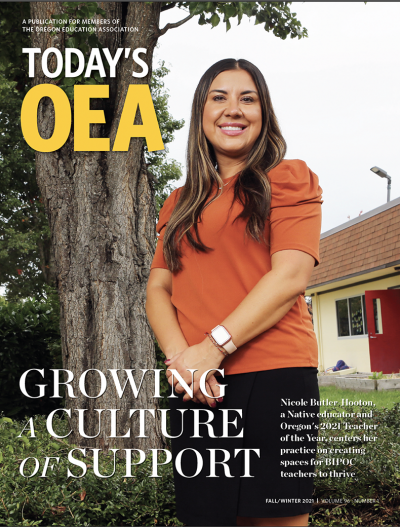Over the past 18 months since President Barack Obama signed the Every Student Succeeds Act into law, OEA has been asking you three very important questions.
- What is something you had to do as an educator under No Child Left Behind that you knew was bad for students?
- What is a hidden success in your school, something your school does well that falls outside of reading, writing and math?
- If you could do one thing in your school to improve teaching and learning, what would it be?
Unsurprisingly, you are quick to answer that first question. We have been naming, calling out, and organizing against the harmful effects of NCLB for 15 years. Too much time spent on high-stakes testing. Students losing out on enrichment opportunities in place of interventions. Scripted curriculum that our leaders guarantee will finally be the solution to student growth.
Teachers can also easily call out the hidden gems of their schools and the amazing work going on in classrooms. Maybe it’s the planetary STEAM program or the robust community garden or the bilingual parent group.
Great work is being done in our schools, but rarely do we get to celebrate those programs outside of the small school community. Instead, test scores and report cards often overshadow the much more relevant and meaningful programs that inspire students’ natural curiosity and desire to learn.What ESSA finally gives us is a way to take action to end harmful practices, promote what is working in our schools, and to add back what we know improves teaching and learning.
On Ramps to Organizing
The best way to approach ESSA is to think first about the goals you have for improving teaching and learning, and then consider the parts of ESSA that can support those goals. This is opposite of how we approached NCLB, which was compliance driven. ESSA is about opportunity, not compliance.
OEA member responses to our three critical questions reveal five distinct opportunities to organize for improved teaching and learning, using provisions of ESSA to support the work. One way to think of these opportunities are as on-ramps, or entry points, to improving schools. They are:
- Professional learning;
- Educator evaluations and support systems;
- Assessment systems;
- School improvement;
- A well-rounded education.
More opportunities exist beyond these five, and we encourage members to share their organizing ideas and successes with us at oea-essa@oregoned.org.
Professional Learning
Each and every educator — from the superintendent to the bus driver — needs ongoing learning in order to improve. ESSA redefines professional learning as ongoing, sustained, job-embedded, and classroom focused. The legislation specifically says that one-time conferences or workshops are not high quality learning unless they are part of a bigger plan.
ESSA also requires school districts to consult with organizations that represent educators on how to spend Title IIA funds. Title IIA funds are intended to support effective instruction. School districts often use this money to pay for professional development and learning, and to lower class sizes; however, classroom teachers, specialized instructional support personnel (such as counselors and speech pathologists), and education support professionals are often left out of the conversation on how best to use those funds.
ESSA opens the door to organize for higher quality professional learning for all educators. Some ways to organize to improve professional learning include:
- Bargaining for the creation of a collaborative labor/management professional learning committee;
- Advocating for educator-led professional learning;
- Pursuing more autonomy of professional learning time, like staff meetings, PLCs/PLTs, or staff development days.
Unfortunately, President Trump’s proposed 2018 budget drastically cuts federal Title IIA funds. Oregon educators should contact their congressional delegation (see page 12) to let them know the disastrous effects such cuts would have on classrooms and quality teaching.
Educator Evaluation and Support Systems
The last few years of NCLB brought us the era of the NCLB waivers. States, including Oregon, had to agree to tie teacher evaluations to student test scores to get these waivers. Congress saw these waivers as an overreach of federal authority and so ESSA explicitly says the U.S. Department of Education cannot mandate any aspect of a state evaluation system or even mandate that a state has an evaluation system.
Oregon’s education evaluation and support system remains in place, but the Oregon Department of Education has removed the link between high-stakes test scores and teacher evaluations. Further changes will be considered at the State Board of Education’s May 26, 2017 meeting (final results were not available at the time of publication).
The intent of Oregon’s system is to support educators and provide professional learning and growth opportunities identified through the evaluation process. Rather than just identify areas for improvement or deficiencies, the system is supposed to celebrate teacher strengths while providing support in other areas.
Additionally, the intent of Oregon’s system is for school district leaders and educators to work collaboratively to develop a professional growth and evaluation system that inspires quality practice. When the law passed in 2012, some school districts embraced the spirit of collaboration while others continued with business as usual.
Now that the federal government doesn’t hold the evaluation stick, so to speak, and Oregon leaders have renewed their commitment to a supportive evaluative system, OEA members have the opportunity to organize for improved professional growth and evaluation systems. If a district failed to get it right the first time, this is the chance to push for a truly collaborative evaluation system.
What ESSA gives us finally is a way to take action to end harmful practices, promote what is working in our schools, and to add back what we know improves teaching and learning.
Balanced System of Assessment
The area of NCLB members have voiced the most concern about is high-stakes testing. NCLB brought us the era of test-and-punish. While ESSA doesn’t completely right these wrongs, it does lessen the overall impact of test scores.
The opportunities to organize for a better and more balanced system of assessment, using ESSA as the starting point, are many, and include:
- Calling for a district assessment audit to examine all district and school-mandated assessments, reduce redundancies, and ensure that the test is being used for its intended purpose;
- Taking an inventory of district and school-mandated assessments;
- Advocating for a cap on time spent on state, district, and school mandated tests and the time spent preparing to take the tests;
- Asking school boards to take a public stance on standardized testing;
- And ensuring all families and parents have access to Oregon’s opt-out system.
School Improvement
Under NCLB and the waiver system, schools that were identified as in need of improvement had a limited set of options to choose from. Additionally, federal School Improvement Grants were competitive and schools that needed resources the most might not have received the grants.
ESSA deliberately puts local school communities — educators, leaders, families, and community organizations — in charge of writing school improvement plans. This August, the Oregon Department of Education will redesignate Oregon schools. ODE has eliminated the Priority, Focus, and Model school structure. Instead, schools will be designated as Comprehensive Support Schools, Targeted Support Schools, or no designation. For more on Oregon’s new accountability and school improvement system, see www.oregoned.org/essa.
Schools identified as either Comprehensive or Targeted Support Schools will have a year to develop improvement plans that will go into effect in the 2018-19 school year. Educators in those schools should begin conversations with principals and district leaders now about how best to collaborate to write, implement, and monitor improvement plans.
Well-Rounded Education
An exciting shift in NCLB from ESSA is its focus on providing all students with a well-rounded education. This was also a key theme in Oregon’s ESSA plan, which was submitted to the U.S. Department of Education in early May.
ESSA defines a well-rounded education as courses, activities, and programming in English, reading, writing, science, technology, engineering, mathematics, foreign languages, civics and government, economics, art, history, geography, computer science, music, career and technical education, health, physical education, and any other subject a state or school district decides.
Additionally, ESSA includes a new section in Title IV called Student Support and Enrichment Grants that would help fund access to a well-rounded education. Unfortunately, as with Title IIA, President Trump’s proposed 2018 budget would cut much of the funding for these programs.
Educators can organize now to contact our Oregon congressional delegation and let them know that Oregonians value a well-rounded education for our students. Federal Title IV funds are essential for providing the kind of rich educational experience that students deserve.
Moving Forward
There are many ways to move forward with your organizing efforts. First, visit our ESSA website at www.oregoned.org/essa to access the many resources on ESSA there, including the Educator-Led Improvement Toolkit. This toolkit has all the resources you need to start an organizing effort in your school or local association.
You can contact Karen Hoffman (karen.hoffman@oregoned.org) in the Center for Great Public Schools to help get you started and to provide support for your plan. The Center for Great Public Schools staff and key member leaders will also lead an all-day workshop on using ESSA to organize at the annual OEA Summer Leadership Conference this year.
It’s time to embrace the promise of ESSA, lift our voices, and organize for the schools our students deserve.

